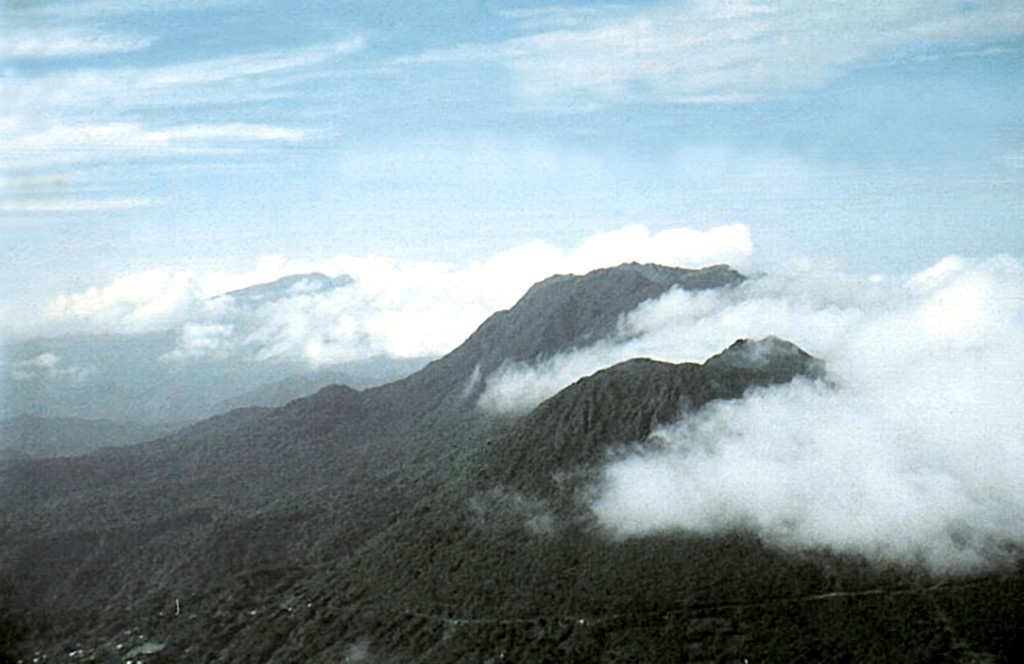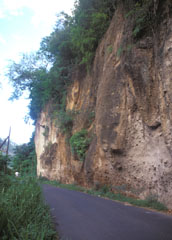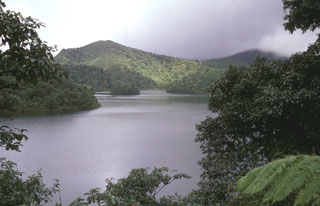

Seismicity returns to normal levels
The increased seismic activity that began 10 February gradually declined and had returned to normal by late May.
Information Contacts: W. Aspinall, UWI.
The Global Volcanism Program has no Weekly Reports available for Morne Trois Pitons.
Reports are organized chronologically and indexed below by Month/Year (Publication Volume:Number), and include a one-line summary. Click on the index link or scroll down to read the reports.
Seismic swarm during February-March
On 10 February a local earthquake swarm began on the island of Dominica. Only 12 events were recorded during the next month, but they increased sharply following a regional earthquake (M 5.9) 170 km to the N on 10 March. The largest event of this swarm was 14 March at 2115, but was not recorded on the WWSSN despite a locally estimated intensity of MM VI. On 30 March a 5-station seismograph net was established by a team from the Seismic Research Unit of the University of the West Indies, Trinidad. They have since located over 40 earthquakes with focal depths of generally <3 km. Activity was generally concentrated in a belt extending beneath Roseau, capital of the island, and up to 2 km offshore to the SW.
. . . There has been neither increased steam venting at the nearby Watten Waven Soufrière (inspected on 11 April by John Tomblin, Director of the Seismic Research Unit) nor additional indications of volcanic activity reported elsewhere on the island. Furthermore, earthquake frequency was decreasing toward the end of April and focal depths appeared to be increasing. Similar earthquake swarms in Dominica have been recorded in 1974 and 1971, but they were felt less in the capital city and were therefore less conspicuous. Apart from a minor phreatic explosion in 1880, there has been no historic volcanism on Dominica. Tomblin interprets the recent earthquake as subsurface migration of magma, but feels that the risk of an eruption in the near future is decreasing. The Seismic Research Unit team is continuing to keep a close watch on geophysical activity in Dominica.
Information Contacts: J. Tomblin, UWI; W. Person, NEIS.
Seismicity continues in May
The trend of decreasing earthquake frequency reported last month did not continue into early May nor did the apparent trend toward increasing focal depths. Seismographs recorded 1-3 events per day in early May with depths of 1.2-2.2 km. Scientists from the University of West Indies' Seismic Research Unit have continued monitoring the activity with a telemetered network.
Information Contacts: Seismic Research Unit, UWI.
Seismicity returns to normal levels
The increased seismic activity that began 10 February gradually declined and had returned to normal by late May.
Information Contacts: W. Aspinall, UWI.
|
|
||||||||||||||||||||||||||
There is data available for 2 confirmed Holocene eruptive periods.
0920 ± 50 years Confirmed Eruption (Explosive / Effusive)
| Episode 1 | Eruption (Explosive / Effusive) | Micotrin? | |||||||||||||||||||
|---|---|---|---|---|---|---|---|---|---|---|---|---|---|---|---|---|---|---|---|---|
| 0920 ± 50 years - Unknown | Evidence from Isotopic: 14C (uncalibrated) | |||||||||||||||||||
|
List of 2 Events for Episode 1 at Micotrin?
|
||||||||||||||||||||
0790 ± 50 years Confirmed Eruption (Explosive / Effusive)
| Episode 1 | Eruption (Explosive / Effusive) | Micotrin? | ||||||||||||||||||||||||
|---|---|---|---|---|---|---|---|---|---|---|---|---|---|---|---|---|---|---|---|---|---|---|---|---|---|
| 0790 ± 50 years - Unknown | Evidence from Isotopic: 14C (uncalibrated) | ||||||||||||||||||||||||
|
List of 3 Events for Episode 1 at Micotrin?
|
|||||||||||||||||||||||||
This compilation of synonyms and subsidiary features may not be comprehensive. Features are organized into four major categories: Cones, Craters, Domes, and Thermal Features. Synonyms of features appear indented below the primary name. In some cases additional feature type, elevation, or location details are provided.
Craters |
||||
| Feature Name | Feature Type | Elevation | Latitude | Longitude |
| Wotten Waven | Pleistocene caldera | 15° 19' 0.00" N | 61° 20' 0.00" W | |
Domes |
||||
| Feature Name | Feature Type | Elevation | Latitude | Longitude |
| Micotrin
Macaque, Morne |
Dome | 1220 m | 15° 20' 0.00" N | 61° 20' 0.00" W |
 Two large lava domes, Micotrin (lower right) and Morne Trois Pitons (upper right), are located along the margin of a large semi-circular depression on the western coast of central Dominica NE of the capital city of Roseau. The village of Laudat at the lower left lies along a road traversing the flanks of Micotrin on the way to the Atlantic coast. The most recent dated dome-forming eruption at the Trois Pitons/Micotrin complex took place about 800 CE. Morne Diablotins volcano lies in the clouds at the upper left.
Two large lava domes, Micotrin (lower right) and Morne Trois Pitons (upper right), are located along the margin of a large semi-circular depression on the western coast of central Dominica NE of the capital city of Roseau. The village of Laudat at the lower left lies along a road traversing the flanks of Micotrin on the way to the Atlantic coast. The most recent dated dome-forming eruption at the Trois Pitons/Micotrin complex took place about 800 CE. Morne Diablotins volcano lies in the clouds at the upper left.  A roadcut in the Roseau River valley on the outskirts of the capital city reveals deposits of the Roseau Tuff. This thick sequence of pyroclastic flows (sometimes welded), pyroclastic surges, and pumice-lapilli airfall deposits was erupted between about 40,000 and 25,000 years ago.
A roadcut in the Roseau River valley on the outskirts of the capital city reveals deposits of the Roseau Tuff. This thick sequence of pyroclastic flows (sometimes welded), pyroclastic surges, and pumice-lapilli airfall deposits was erupted between about 40,000 and 25,000 years ago.  Freshwater Lake (L'Etang) lies in the moat between Micotrin lava dome and the eastern wall of the Wotten Waven caldera, partially visible in the background. The 7 x 4.5 x wide caldera is elongated in an SW-NE direction, and it extends on the SW to near the capital city of Roseau. The two coalesced lava domes of Micotrin straddle the NE rim of the caldera. Strong geothermal activity persists in the caldera, the most prominent of which lies near the village of Wotten Waven along the River Blanc and contains numerous bubbling pools and fumaroles.
Freshwater Lake (L'Etang) lies in the moat between Micotrin lava dome and the eastern wall of the Wotten Waven caldera, partially visible in the background. The 7 x 4.5 x wide caldera is elongated in an SW-NE direction, and it extends on the SW to near the capital city of Roseau. The two coalesced lava domes of Micotrin straddle the NE rim of the caldera. Strong geothermal activity persists in the caldera, the most prominent of which lies near the village of Wotten Waven along the River Blanc and contains numerous bubbling pools and fumaroles.There are no samples for Morne Trois Pitons in the Smithsonian's NMNH Department of Mineral Sciences Rock and Ore collection.
| Copernicus Browser | The Copernicus Browser replaced the Sentinel Hub Playground browser in 2023, to provide access to Earth observation archives from the Copernicus Data Space Ecosystem, the main distribution platform for data from the EU Copernicus missions. |
| MIROVA | Middle InfraRed Observation of Volcanic Activity (MIROVA) is a near real time volcanic hot-spot detection system based on the analysis of MODIS (Moderate Resolution Imaging Spectroradiometer) data. In particular, MIROVA uses the Middle InfraRed Radiation (MIR), measured over target volcanoes, in order to detect, locate and measure the heat radiation sourced from volcanic activity. |
| MODVOLC Thermal Alerts | Using infrared satellite Moderate Resolution Imaging Spectroradiometer (MODIS) data, scientists at the Hawai'i Institute of Geophysics and Planetology, University of Hawai'i, developed an automated system called MODVOLC to map thermal hot-spots in near real time. For each MODIS image, the algorithm automatically scans each 1 km pixel within it to check for high-temperature hot-spots. When one is found the date, time, location, and intensity are recorded. MODIS looks at every square km of the Earth every 48 hours, once during the day and once during the night, and the presence of two MODIS sensors in space allows at least four hot-spot observations every two days. Each day updated global maps are compiled to display the locations of all hot spots detected in the previous 24 hours. There is a drop-down list with volcano names which allow users to 'zoom-in' and examine the distribution of hot-spots at a variety of spatial scales. |
|
WOVOdat
Single Volcano View Temporal Evolution of Unrest Side by Side Volcanoes |
WOVOdat is a database of volcanic unrest; instrumentally and visually recorded changes in seismicity, ground deformation, gas emission, and other parameters from their normal baselines. It is sponsored by the World Organization of Volcano Observatories (WOVO) and presently hosted at the Earth Observatory of Singapore.
GVMID Data on Volcano Monitoring Infrastructure The Global Volcano Monitoring Infrastructure Database GVMID, is aimed at documenting and improving capabilities of volcano monitoring from the ground and space. GVMID should provide a snapshot and baseline view of the techniques and instrumentation that are in place at various volcanoes, which can be use by volcano observatories as reference to setup new monitoring system or improving networks at a specific volcano. These data will allow identification of what monitoring gaps exist, which can be then targeted by remote sensing infrastructure and future instrument deployments. |
| Volcanic Hazard Maps | The IAVCEI Commission on Volcanic Hazards and Risk has a Volcanic Hazard Maps database designed to serve as a resource for hazard mappers (or other interested parties) to explore how common issues in hazard map development have been addressed at different volcanoes, in different countries, for different hazards, and for different intended audiences. In addition to the comprehensive, searchable Volcanic Hazard Maps Database, this website contains information about diversity of volcanic hazard maps, illustrated using examples from the database. This site is for educational purposes related to volcanic hazard maps. Hazard maps found on this website should not be used for emergency purposes. For the most recent, official hazard map for a particular volcano, please seek out the proper institutional authorities on the matter. |
| IRIS seismic stations/networks | Incorporated Research Institutions for Seismology (IRIS) Data Services map showing the location of seismic stations from all available networks (permanent or temporary) within a radius of 0.18° (about 20 km at mid-latitudes) from the given location of Morne Trois Pitons. Users can customize a variety of filters and options in the left panel. Note that if there are no stations are known the map will default to show the entire world with a "No data matched request" error notice. |
| UNAVCO GPS/GNSS stations | Geodetic Data Services map from UNAVCO showing the location of GPS/GNSS stations from all available networks (permanent or temporary) within a radius of 20 km from the given location of Morne Trois Pitons. Users can customize the data search based on station or network names, location, and time window. Requires Adobe Flash Player. |
| DECADE Data | The DECADE portal, still in the developmental stage, serves as an example of the proposed interoperability between The Smithsonian Institution's Global Volcanism Program, the Mapping Gas Emissions (MaGa) Database, and the EarthChem Geochemical Portal. The Deep Earth Carbon Degassing (DECADE) initiative seeks to use new and established technologies to determine accurate global fluxes of volcanic CO2 to the atmosphere, but installing CO2 monitoring networks on 20 of the world's 150 most actively degassing volcanoes. The group uses related laboratory-based studies (direct gas sampling and analysis, melt inclusions) to provide new data for direct degassing of deep earth carbon to the atmosphere. |
| Large Eruptions of Morne Trois Pitons | Information about large Quaternary eruptions (VEI >= 4) is cataloged in the Large Magnitude Explosive Volcanic Eruptions (LaMEVE) database of the Volcano Global Risk Identification and Analysis Project (VOGRIPA). |
| EarthChem | EarthChem develops and maintains databases, software, and services that support the preservation, discovery, access and analysis of geochemical data, and facilitate their integration with the broad array of other available earth science parameters. EarthChem is operated by a joint team of disciplinary scientists, data scientists, data managers and information technology developers who are part of the NSF-funded data facility Integrated Earth Data Applications (IEDA). IEDA is a collaborative effort of EarthChem and the Marine Geoscience Data System (MGDS). |